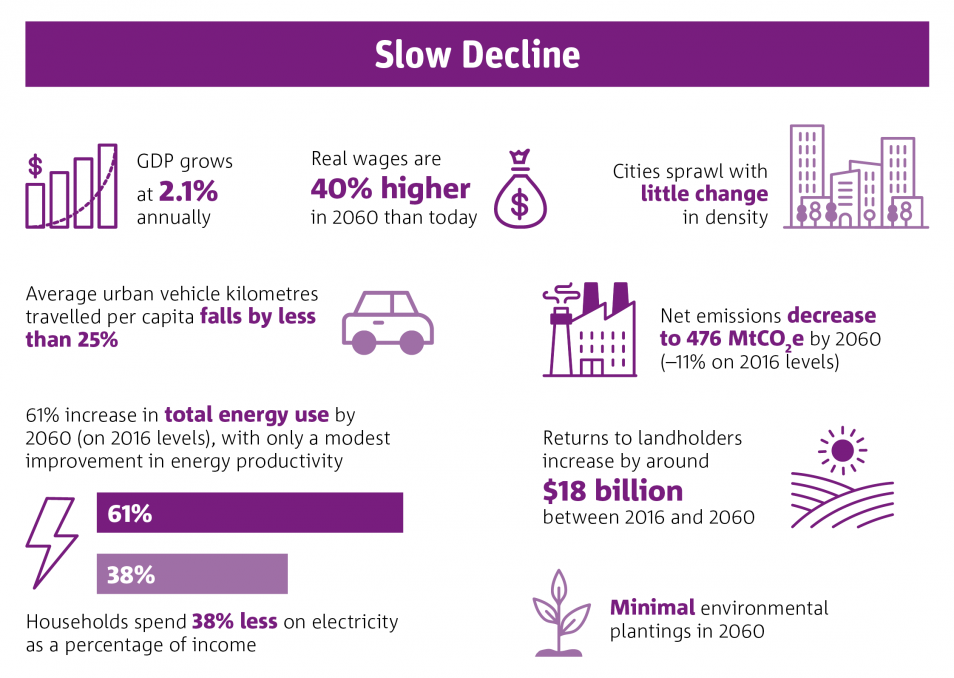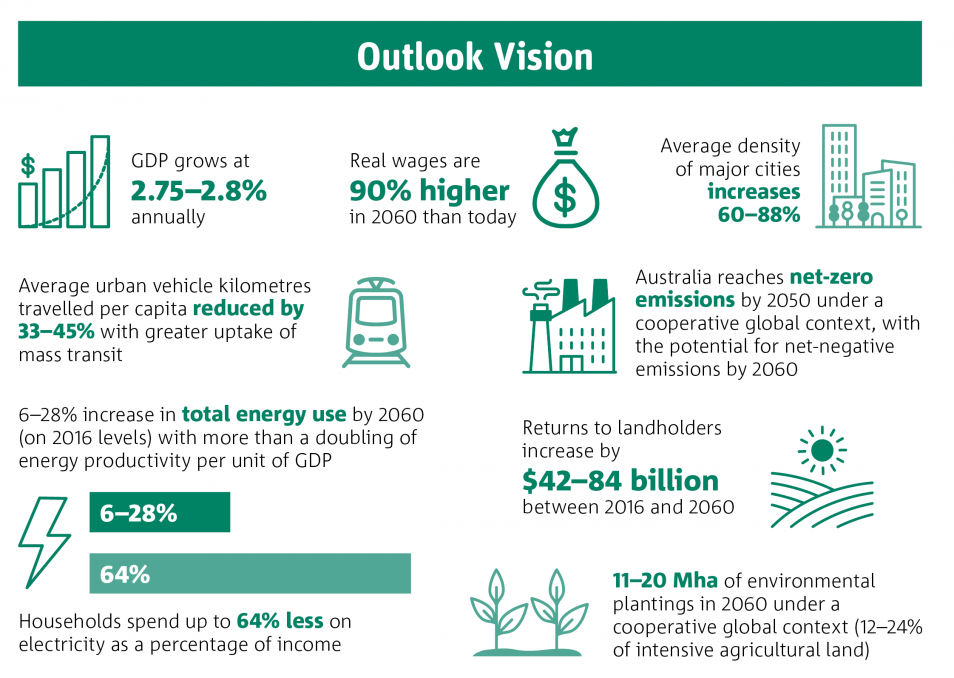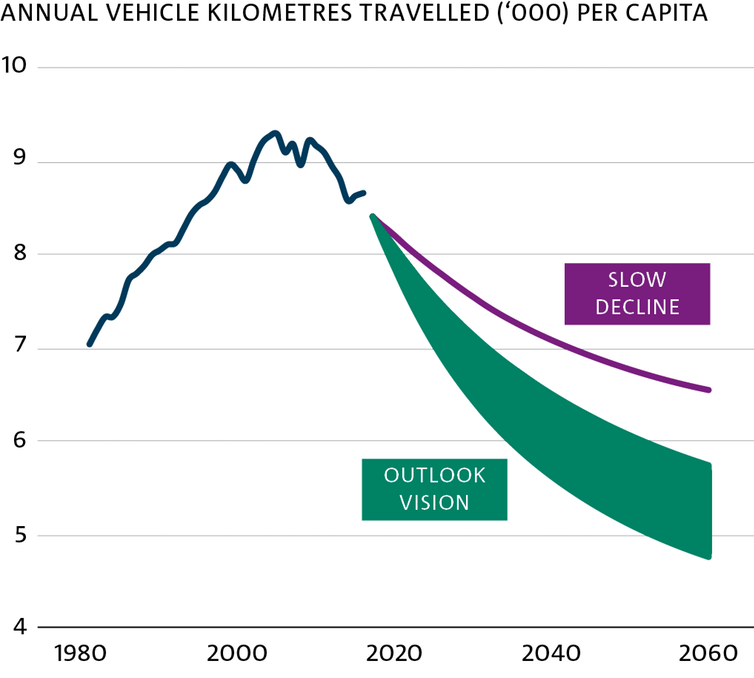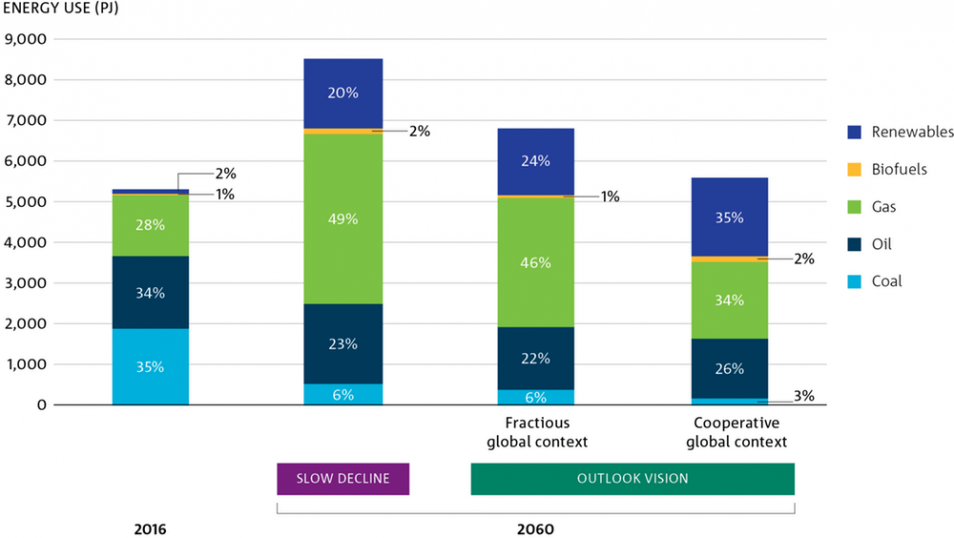
This article was first published in The Conversation.
Australia’s future prosperity is at risk unless we take bold action and commit to long-term thinking. This is the key message contained in the Australian National Outlook 2019 (ANO 2019), a report that we published today with our partners.
Our new research used a scenario approach to model different visions of Australia in 2060.
We contrasted two core scenarios: a base case called Slow Decline, and an Outlook Vision scenario which represents what Australia could achieve. These scenarios took account of 13 different national issues, as well as two global contexts relating to trade and action on climate change.
We found there are profound differences in long-term outcomes between these two scenarios.
Slow decline versus a new outlook
Australia’s living standards – as measured by Gross Domestic Product (GDP) per capita – could be 36% higher in 2060 in the Outlook Vision, compared with Slow Decline. This translates into a 90% increase in average wages (in real terms, adjusted for inflation) from today.

In the Slow Decline scenario, Australia fails to adequately address identified challenges. Image: CSIRO

The Outlook Vision scenario shows what could be possible if Australia meets identified challenges. Image: CSIRO
Australia could maintain its world-class, highly liveable cities, while increasing its population to 41 million people by 2060. Urban congestion could be reduced, with per capita passenger vehicle travel 45% lower than today in the Outlook Vision.

Australia’s real GDP per capita in 2016, and the modelled outcomes for Slow Decline and Outlook Vision. In Outlook Vision, the darker shade shows outcomes under a cooperative global context and the lighter shade under a fractious global context. Image: CSIRO
Australia could achieve net-zero emissions by 2050 while reducing household spend on electricity (relative to incomes) by up to 64%. Importantly, our modelling shows this could be achieved without significant impact on economic growth.
Low-emissions, low-cost energy could even become a source of comparative advantage for Australia, opening up new export opportunities.
And inflation-adjusted returns to rural landholders in Australia could triple to 2060, with the land sector contribution to GDP increasing from around 2% today to over 5%.
At the same time, ecosystems could be restored through more biodiverse plantings and land management.

Historical trend for vehicle kms travelled (VKT) on urban roads, per capita, and projections resulting from the modelled Slow Decline and Outlook Vision scenarios. The shaded area for Outlook Vision represents the range of outcomes possible depending on how regional satellites cities develop. Image: CSIRO
The report, developed over the last two years, explores what Australia must do to secure a future with prosperous and globally competitive industries, inclusive and enabling communities, and sustainable natural endowments, all underpinned by strong public and civic institutions.
ANO 2019 uses our integrated modelling framework to project economic, environmental and social outcomes to 2060 across multiple scenarios.
The outlook also features input from more than 50 senior leaders drawn from Australia’s leading companies, universities and not-for-profits.
So how do we get there?
Achieving the outcomes in the Outlook Vision won’t be easy.
Australia will need to address the major challenges it faces, including the rise of Asia, technology disruption, climate change, changing demographics, and declining social cohesion. This will require long-term thinking and bold action across five major “shifts”:
- industry shift
- urban shift
- energy shift
- land shift
- culture shift.
The report outlines the major actions that will underpin each of these shifts.
For example, the industry shift would see Australian firms adopt new technologies (such as automation and artificial intelligence) to boost productivity, which accounts for a little over half of the difference in living standards between the Outlook Vision and Slow Decline.
Developing human capital (through education and training) and investment in high-growth, export-facing industries (such as healthcare and advanced manufacturing) each account for around 20% of the difference between the two scenarios.
The urban shift would see Australia increase the density of its major cities by between 60-88%, while spreading this density across a wider cross-section of the urban landscape (such as multiple centres).
Combining this density with a greater diversity of housing types and land uses will allow more people to live closer to high-quality jobs, education, and services.
Enhancing transport infrastructure to support multi-centric cities, more active transport, and autonomous vehicles will alleviate congestion and enable the “30-minute city”.
In the energy shift, across every scenario modelled, the electricity sector transitions to nearly 100% renewable generation by 2050, driven by market forces and declining electricity generation and storage costs.
Likewise, electric vehicles are on pace to hit price-parity with petrol ones by the mid-2020s and could account for 80% of passenger vehicles by 2060.
In addition, Australia could triple its energy productivity by 2060, meaning it would use only 6% more energy than today, despite the population growing by over 60% and GDP more than tripling.

Primary energy use in Australia under the modelled scenarios. Primary energy is the measure of energy before it has been converted or transformed, and includes electricity plus combustion of fuels in industry, commercial, residential and transport. Image: CSIRO
The land shift would require boosting agricultural productivity (through a combination of plant genomics and digital agriculture) and changing how we use our land.
By 2060, up to 30 million hectares – or roughly half of Australia’s marginal land within more intensively farmed areas – could be profitably transitioned to carbon plantings, which would increase returns to landholders and offset emissions from other sectors.
As much as 700 millions of tonnes of CO₂ equivalent could be offset in 2060, which would allow Australia to become a net exporter of carbon credits.
A culture shift
The last, and perhaps most important shift, is the cultural shift.
Trust in government and industry has eroded in recent years, and Australia hasn’t escaped this trend. If these institutions, which have served Australia so well in its past, cannot regain the public’s trust, it will be difficult to achieve the long-term actions that underpin the other four shifts.
Unfortunately, there is no silver bullet here.


30th June 2019 at 8:35 am
I found these comments from others particularly interesting and insightful but not very hopeful for our future.
Aboriginal people lived here for over 40,000 years and there were less than a million people here when Cook landed. They managed this country as one huge estate and if we are to move forward safely into the future we need to be asking their advice on how we can accomplish this. Population control should already be implemented and new farming methods applied with diversity. Desalination plants should be built now and plant more trees. Twenty five million Elm Trees have died on this planet and now the Ash Trees are going the same way with diseases, no trees means no life for humans.
I suggest you read 2 books “Trees of Romance and History by Michael Pembroke and “Call of the Reed Warbler” by Charles Massy. A war or natural disasters will obviously change many things that we can’t foresee and will have to navigate our way through as best we can with the knowledge we have. I don’t think we can predict how it will be in 2060 other than going step by step with whatever situation occurs and hopefully make better decisions, less rushing
and greed and more meditative forethought.
It’s the biggest refugee crisis in history and if we don’t have World Leader meetings to put pressure on the tyrannical
dictators that are running these countries to be better human beings and treat their people with integrity and compassion or the refugee crisis will continue with a huge imbalance in the world.
29th June 2019 at 3:38 pm
I am thrilled that Australia is boldly looking to the future with an exciting plan. Love our CSIRO.
I would like to see embedded in this future planning an absolute commitment to the acceptance of the Uluru statement by the federal government. Plans for the future are all about the people and indigenous Australians have waited far too long to have an effective voice in that future plan.
29th June 2019 at 11:30 am
Invent your own future. The “Outlook Vision” is achievable, and more. Clarity in this vision is essential, complimented with a sound plan of measurable strategies delivered through achievable goals that are attained by executing realistic ‘tasks’. That’s the easy part! Success in moving towards our “Vision” is driven by our culture – the way we do things here is Australia. That ‘culture’ MUST be influenced by our leaders and each other. We all have a role to play. The better leaders influence behaviour which in turn builds critical mass creating a winning culture that delivers high performance. I agree there needs to be bold action across those five major shifts. Cultural shift in building trust will prove to be the most influential in getting those other ‘shifts’ across the line. Only action is action. Demand nothing short of the best for our future and achieve our vision.
29th June 2019 at 9:32 am
Did I miss it? Do the words optimistic or optimism appear in the report?
28th June 2019 at 9:21 pm
There are just so many factors, this is a very macro list which poses more questions than it answers. Just as an example “autonomous vehicles to boost productivity” puts drivers out of work. That’s fine we all know its coming. Now multiply this across almost every industry and that leads to a whole lot of unemployment.
The counter argument to that is that “people will be doing jobs that we haven’t even thought of yet”. Well someone better start making up jobs now because autonomous vehicles are almost here and will be replacing drivers very soon – I’d imagine within two decades at least. That is only one industry.
Small business is in jeopardy as big business snowballs and government regulates more. With every “Licence” comes a new fee. Small business just can’t compete against big business in price. This problem just escalates.
In Perth businesses are closing all over as they can’t afford the outrageous lease prices or can’t stay competetive. Brick and mortar stores in retail are being replaced by mass produced imported products bought over the internet or digital products that don’t require a physical presence.
Australian jobs are being eroded with no real plan of action to replace them.
We have Australian farmers selling meat overseas for outrageous prices while supplying lower grade to Australians for just as outrageous prices (when was the last time you had a decent steak for a decent price?)
Wages / salary increase by 40% – 90% by 2060 ***IF you’re lucky enough to have a job!***? Awesome! Now whats the estimate cost of living increase? I can guarantee you it will be far more than the income increase.
Most people I know (including me) haven’t had a wage increase in over 5 years – minimum wage has gone up a couple of times in the last 5 years, so we’re getting closer to minimum wage with no outlook for wage increases on the horizon.
My outlook for the future is far more bleak as we’ve taken no steps to counter some of the REAL issues.
Carbon emissions is small fish to fry when people can barely afford their week to week.